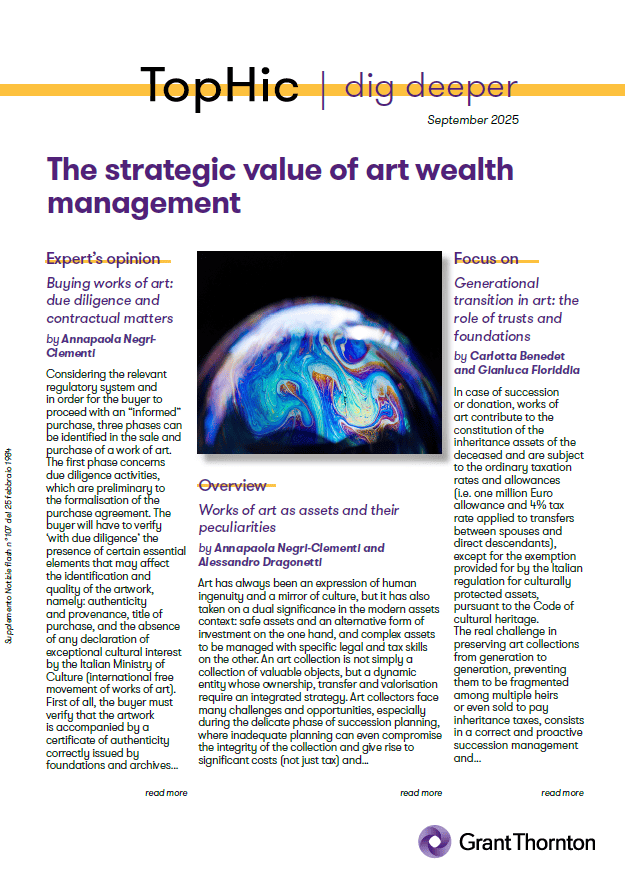
In case of succession or donation, works of art contribute to the constitution of the inheritance assets of the deceased and are subject to the ordinary taxation rates and allowances (i.e. one million Euro allowance and 4% tax rate applied to transfers between spouses and direct descendants), except for the exemption provided for by the Italian regulation for culturally protected assets, pursuant to the Code of cultural heritage.
The real challenge in preserving art collections from generation to generation, preventing them to be fragmented among multiple heirs or even sold to pay inheritance taxes, consists in a correct and proactive succession management and planning for such works.
In fact, just waiting for succession is not the best strategy to follow, also for the recognition of the historical-cultural interest of the work, which is the basis for the exemption from the payment of inheritance tax, since the procedure is not limited to ascertaining the existence of the objective requirements provided for by the regulation (work older than 70 years by a deceased artist), but also requires a declaration of cultural significance to be issued by the Ministry, so it is far from straightforward.
Therefore, it is crucial for the collectors to decide on the future of their collections: should they be maintained jointly? Should they be managed by a specific heir – perhaps more passionate? Should they be available to the public? Answering these questions allows identifying the most appropriate legal instruments to safeguard and transfer works of art.
A simple will, in fact, could not be sufficient to solve potential conflicts or ensure a uniform management of collections. Disputes between heirs for the division of assets often lead to selling off important works to meet legitimate shares, thus destroying the cultural and economic value of the collection as a whole.
Planning is not only aimed to mere tax optimization but is also the highest act of protection of one’s passion and cultural legacy, ensuring that future generations can enjoy them according to the collector’s vision.
To overcome some limitations of traditional instruments, such as will (which remains a crucial and unavoidable succession planning instrument, to be accompanied by more protective instruments for some specific assets, such as work of arts or collectible items) or joint heirship, the Italian regulation offers more sophisticated and flexible options to manage and transfer collections of works of art and/or of collectible items in general, such as trusts and foundations. In fact, these allow “segregating” collections from the collector’s personal wealth, entrusting its management to a third party (the trustee, in the case of trusts, or the board of directors in the case of foundations) in the interest of the designated beneficiaries and for the achievement of a specific purpose, which is defined at the beginning by the collector or later by the persons in charge of carrying out the collector's wishes (i.e., the trustee).
Trusts have Anglo-Saxon origins but are not fully recognised in Italy and stand out for their high flexibility. The collector (executor) transfers their work to a trustee (either a trusted person or a professional trust company), who manages them according to the rules included in the trust deed. Therefore, the executor can give scrupulous instructions on the management, maintenance, valorisation, and any sale of works, as well as on the use by the beneficiaries (e.g., children, grandchildren, or a group of enthusiasts). The trust allows achieving multiple objectives:
- It maintains the collection integrity, thus avoiding its fragmentation among heirs (the trustee manages the artistic heritage as a unique entity, according to the collector’s vision);
- It ensures a professional management of the collection and/or of the trusted assets in general, as it gives the possibility to appoint as trustee or protector (who supervises the trustee’s activities) experts in the field;
- It offers asset protection: trusted assets constitute separate wealth and cannot be seized by the executor’s creditors or by the trustee’s or the beneficiaries’ creditors;
- It ensures favourable taxation in terms of inheritance or gift tax, since, according to the current regulation, the contribution of works of art to a trust – unless otherwise provided – is subject to a fixed tax and only when the asset is assigned to the beneficiaries the inheritance and/or gift tax is applied proportionally, based on the family relationship between the executor and the beneficiaries, applying the rates and allowances being current at the moment of assignment of the assets.
Given the current tax regulation, if the art collections transferred to the trustee are never assigned to the trust beneficiaries, they can be jointly handed down from generation to generation without paying the inheritance and/or gift tax and ensuring a joint management of the assets, based on the will of the executor-collector.
As an alternative to the trust, a foundation can be established, such as the so-called “family foundation”, i.e. a not-for-profit legal person. If the purpose of the collector is not only to safeguard their artistic heritage, but also to enhance its value for the benefit of the community (e.g., by opening the collection to the public, organising exhibitions, supporting young artists, etc.), the foundation can represent the best choice, as it allows fixing the founder’s will in a by-law, ensuring the perpetuation of their vision over time (besides ensuring, similar to the trust, a joint management of the collection and its entrustment to a skilled board of directors made up, for example, of professionals in the field). From a tax perspective, similar to trusts, foundations can benefit from a preferential regime, especially if they are qualified as Third Sector Organisations.
The choice between trust and foundation depends on the collector’s specific purposes: trusts ensure higher confidentiality and flexibility in the management and attribution of assets and is often preferred for the safeguard of purely family interests; foundations have a more publicistic and philanthropic orientation, which is ideal for those who intend to leave a lasting impact on the community. Both instruments can also be used together, i.e. the trustee can establish a foundation upon the occurrence of certain circumstances (such as the lack of heirs among the trust beneficiaries).
In both cases, a specialized legal and tax advisory is essential for building a tailor-made solution that can protect and enhance the value of a unique heritage as an art collection.
